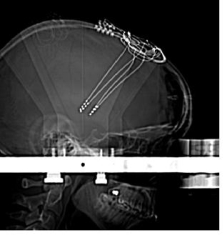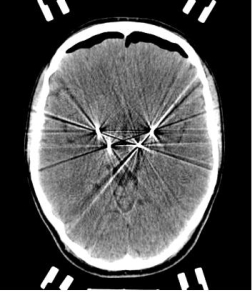Session Information
Date: Thursday, June 23, 2016
Session Title: Dystonia
Session Time: 12:00pm-1:30pm
Location: Exhibit Hall located in Hall B, Level 2
Objective: When a patient presents with both writer’s cramp and other dystonic symptoms, it is unclear which target should be chosen. Multifocal DBS is a new treatment option which can address this issue.
Background: The globus pallidus internus (GPi) has been established as the contemporary target of choice for deep brain stimulation (DBS) in dystonia. The thalamic Vim, however, has been preferred in patients with writer’s cramp.
Methods: A 23- year- old woman with multifocal primary dystonia and prominent writers’ cramp underwent bilateral stereotactic implantation of DBS electrodes in the GPi and the thalamic Vim  . Electrode location was confirmed by postoperative stereotactic CT
. Electrode location was confirmed by postoperative stereotactic CT  . Assessment included the Burke-Fahn- Marsden Dystonia Rating Scale (BFMDRS) motor and disability subscore, 36-item short-form health score (SF-36) and standard video recording. In the frame of a prospective study protocol clinical outcome was assessed before and at 3, 15 and 24 months after surgery.
. Assessment included the Burke-Fahn- Marsden Dystonia Rating Scale (BFMDRS) motor and disability subscore, 36-item short-form health score (SF-36) and standard video recording. In the frame of a prospective study protocol clinical outcome was assessed before and at 3, 15 and 24 months after surgery.
Results: Thalamic stimulation yielded an improvement in writer’s cramp of about 80% according to the BFMDRS subscores. At 3 months follow- up the BFMDRS motor subscore had decreased from 3 before surgery to 0 and the disability subscore had decreased from 6 to 2. The SF- 36 had improved from 31 to 78. At 15 months follow- up the BFM motor subscore had increased to 10 and the disability subscore had increased to 6. The SF- 36 had decreased to 67. After one year the patient presented with an increase in dystonia of the right hand and foot. Vim thalamic stimulation did not have an inpact in the severity of dystonia. Bilateral GPi stimulation improved slightly the dystonic symptoms but did not the writer´s cramp. Because the patient suffered in particularly right- sided dystonia a combined contralateral thalamic and pallidal stimulation was chosen. We saw an improvement of the writer´s cramp and the dystonic foot after the initiation of the combined unilateral bipolar stimulation. The BFM motor subscore had decreased to 6, the disability subscore had decreased to 4 and SF- 36 remained unchanged with 65. The effect was sustained at 24 month follow- up.
Conclusions: Combined thalamic and pallidal stimulation in patients with multifocal primary dystonia under certain circumstances might be an emergent therapy option.
DGNC Annual Meeting, Karlsruhe, Germany, June 07-10, 2015, WSSFN Interim Meeting, Mumbai, September 3-6, 2015.
To cite this abstract in AMA style:
A. Wloch, M. Abdallat, G. Lütjens, C. Schrader, J.K. Krauss. Combined pallidal and thalamic stimulation for multifocal primary dystonia with prominent writers’ cramp [abstract]. Mov Disord. 2016; 31 (suppl 2). https://www.mdsabstracts.org/abstract/combined-pallidal-and-thalamic-stimulation-for-multifocal-primary-dystonia-with-prominent-writers-cramp/. Accessed December 31, 2025.« Back to 2016 International Congress
MDS Abstracts - https://www.mdsabstracts.org/abstract/combined-pallidal-and-thalamic-stimulation-for-multifocal-primary-dystonia-with-prominent-writers-cramp/
